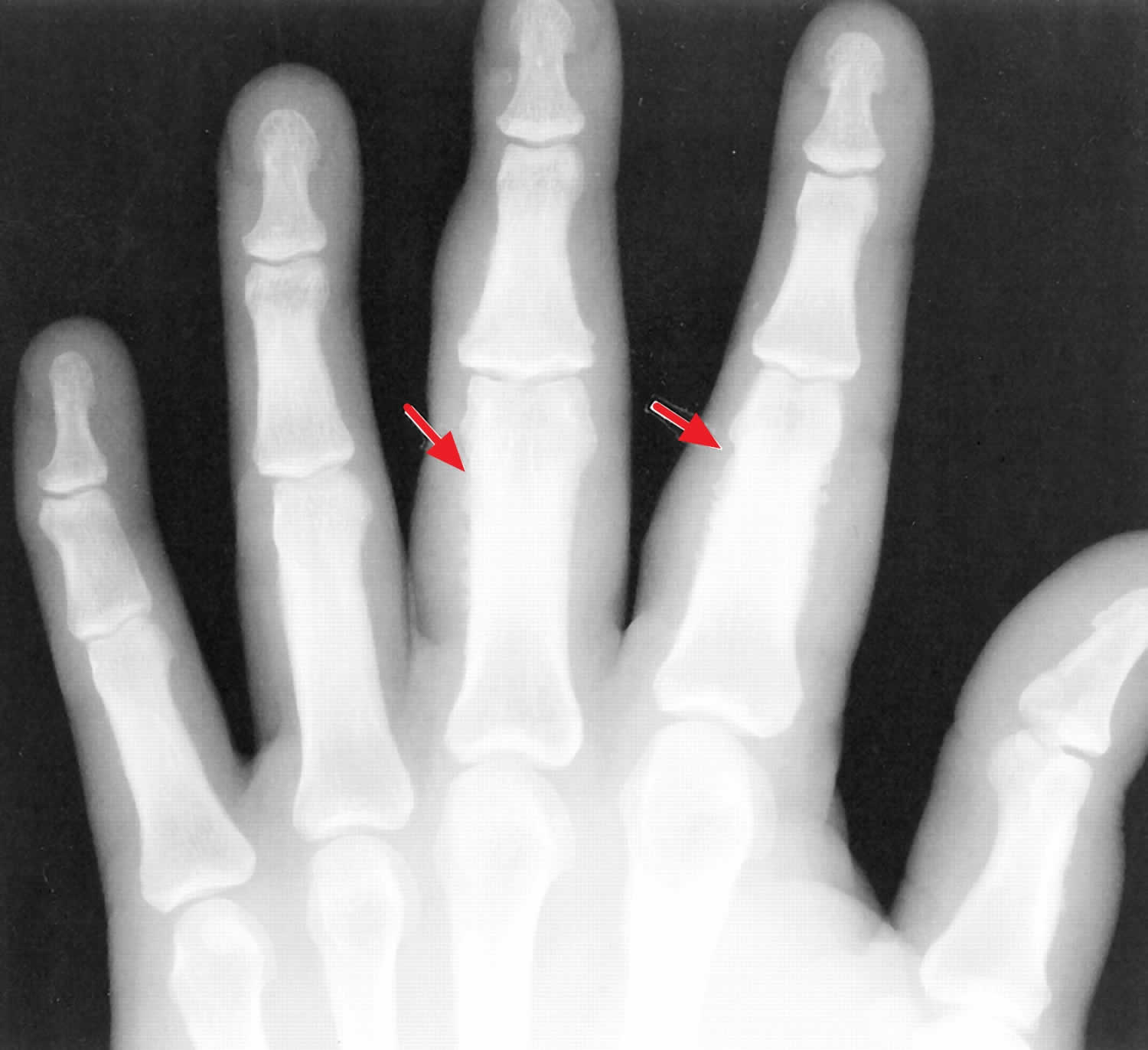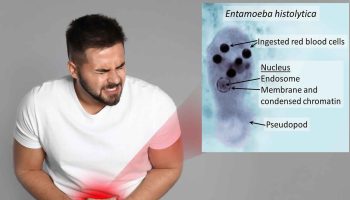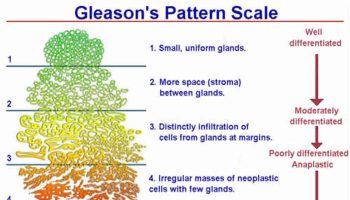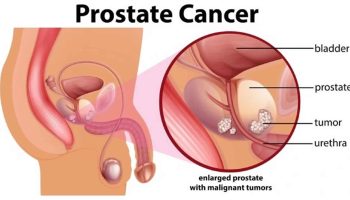Thyroid acropachy
Thyroid acropachy is an uncommon manifestation of autoimmune thyroid disorder that presents with clubbing and swelling of digits along with periosteal reaction of extremity bones 1. Clinically, thyroid acropachy presents as nail clubbing, swelling of digits and toes, almost always in association with thyroid ophthalmopathy (Graves ophthalmopathy) and thyroid dermopathy (pretibial myxedema). On radiographs, it manifests as prominent irregular and spiculated periosteal new bone formation in the hands and feet 1. Thyroid acropachy affects about 0.3% of patients with Graves’ disease and often occurs in euthyroid and hypothyroid patients within weeks to many years after treatment of original thyrotoxicosis 2.
Three types of thyroid acropachy are recognized 3: clubbing of the fingernails (Figure 1) and toenails; swelling and tightness of the skin of fingers and toes (Figure 2) with or without clubbing; and the complete picture, with pain in distal small joints, clubbing, soft tissue swelling, and subperiosteal reaction seen on a radiograph (Figure 3) or bone scan. When substantial thyroid dermopathy of the toes was present, clubbing of the affected toe occasionally was present; however, if there was no clubbing of the upper extremity, the diagnosis of thyroid acropachy was not made 3.
Thyroid acropachy is the least common manifestation of autoimmune thyroid disease. Previous reports indicated that 7% of patients with pretibial myxedema have thyroid acropachy 4. An epidemiological community study showed that about 4% of patients with thyroid ophthalmopathy have thyroid dermopathy, and that one of five patients with thyroid dermopathy has thyroid acropachy 5.
Thyroid acropachy is mostly associated with thyroid ophthalmopathy (Graves ophthalmopathy) and thyroid dermopathy (pretibial myxedema), although an isolated case of acropachy without dermopathy has been reported 6. Thyroid dermopathy is indicative of a severe autoimmune thyroid disease; thyroid acropachy is likely to indicate an even more severe form. Thyroid dermopathy is present in 4% of unselected cases of ophthalmopathy 5 but occurs in 13% of cases of thyroid ophthalmopathy severe enough to require orbital decompression 7.
Thyroid acropachy can occur in all form of autoimmune thyroid disorder whether euthyroid, hypothyroid or hyperthyroid patients 8. Patients first develop thyroid dysfunction, followed by thyroid ophthalmopathy (Graves ophthalmopathy), then thyroid dermopathy (pretibial myxedema), and finally, thyroid acropachy 8. There are some differences between clubbing and periostitis 9 seen in thyroid acropachy and clubbing and pulmonary osteoarthropathy seen in lung and other systemic 10 and paraneoplastic conditions. Thyroid acropachy is distinguished by the uniform presence of thyroid dermopathy and thyroid ophthalmopathy.
Previous reports have indicated that women and men are affected in equal proportions 6. This is not supported by a more recent study, which found a female-to-male ratio of 3.4:1 3.
Fortunately, thyroid acropachy is a relatively benign condition that is often asymptomatic. In advanced cases, when periosteal involvement is present, pain and arthralgia also may be present. Although therapy consisting of glucocorticoids, radiotherapy, immunosuppressive drugs, and surgery may be beneficial in the treatment of thyroid ophthalmopathy and thyroid dermopathy, no effective treatment exists for thyroid acropachy 2.
After long-term follow-up, remission of thyroid acropachy may occur 3. A study by Fatourechi et al 3 did not clarify the percentage of patients with digital clubbing in whom remission of clubbing occurs. Long-term follow-up shows that thyroid dermopathy and thyroid ophthalmopathy, not thyroid acropachy, usually are the sources of the complaint and functional problem.
Figure 1. Thyroid acropachy (clubbing of fingers as the most common form of thyroid acropachy)
Figure 2. Thyroid acropachy fingers
Footnote: Radiograph of the hand in a patient with thyroid acropachy. Note fluffy asymmetric periostitis and soft tissue swelling of the second and third fingers (arrows) and thumb.
Figure 3. Thyroid acropachy toes
Footnote: Radiograph of the toes in a patient with thyroid acropachy. Note soft tissue swelling (arrowhead) and mild fluffy periosteal reaction of the first toe and distal end of the first metatarsal (arrows).
Thyroid acropachy cause
The exact cause of thyroid acropachy is unknown although is thought to be caused by stimulating auto-antibodies to thyroid-stimulating hormone (TSH) and insulin-like growth factor 1 (IGF-1) receptors that are implicated in the pathophysiology of Graves’ thyrotoxicosis and ophthalmopathy 11. Little is known about the pathological characteristics and pathogenesis of thyroid acropachy. One histological study of bone revealed nodular fibrosis of the periosteal area, subperiosteal bone formation, and fibrosis of the marrow space 12. It is unclear whether subclinical pulmonary dysfunction associated with tobacco use contributes to the development of severe thyroid dermopathy and thyroid acropachy 3.
Thyroid acropachy symptoms
Clinically, thyroid acropachy presents as nail clubbing, swelling of digits and toes, almost always in association with thyroid ophthalmopathy (Graves ophthalmopathy) and thyroid dermopathy (pretibial myxedema). In fact, the chronological sequence of extrathyroid manifestations of autoimmune thyroid disease is such that thyroid dysfunction develops first, followed by thyroid ophthalmopathy, then thyroid dermopathy, and finally, thyroid acropachy 13.
In a typical case with full-blown manifestations, there was soft tissue swelling of the hands and feet in association with clubbing of the fingers and toes 3. The skin is commonly pigmented and hyperkeratotic. Although local warmth over the joints (characteristic of pulmonary osteoarthropathy) was absent, 10% of patients reported extremity pain and arthralgia, which eventually resolved. In some patients, the upper extremity almost always was involved. The disease process often is asymmetric, and involvement of a single digit has been reported 14. Although thyroid acropachy often was painless and was diagnosed when the main feature was ophthalmopathy or dermopathy, some patients had lymphatic obstruction, extreme swelling, loss of function, and pain 15. One patient had extremity pain, with the bone scan showing periosteal reaction in the long bones of the lower extremity.
Thyroid acropachy diagnosis
Hyperthyroidism is diagnosed with thyroid function tests.
- Serum thyroid-stimulating hormone (TSH) is usually low.
- If there is a pituitary adenoma (rare), TSH can be high.
- Serum T4 (thyroxine) and T3 (triiodothyronine) levels are usually high.
- In subclinical hyperthyroidism, TSH is low in the presence of normal T4 and T3 level.
Serum autoantibodies are markers of autoimmune disease. They should include:
- Anti-thyroid peroxidase (TPO) antibodies. These are present in 75% of patients with Graves disease and are usually absent in multinodular goitre
- Anti-thyroglobulin antibodies
- TSH receptor antibodies
Full blood count and inflammatory markers, such as C-reactive protein, are routinely included to screen for anaemia (commonly associated with hyperthyroidism) and systemic infection causing thyroiditis.
On imaging, thyroid acropachy exhibits periosteal new bone formation that is highly specific to this syndrome. The periosteal new bone is irregular and spiculated in appearance. Furthermore, these periosteal reactions demonstrate a unique distribution. As such, they tend to be asymmetrical, predominantly involving the hands and feet and only rarely long bones of the forearms and lower legs. The new bone formation tends to be diaphyseal, most pronounced in the midportion of the diaphysis. When the first through fourth metacarpals are involved, changes tend to occur on the radial aspect and when the fifth metacarpal is involved the changes tend to occur on the ulnar aspect of the affected bones 16.
In patients with thyroid acropachy, skin biopsy demonstrates typical findings of pretibial myxedema, including fibroblast activation and glycosaminoglycan deposition. Similar findings have been noted in skin overlying periosteal changes of acropachy 17.
Thyroid acropachy treatment
Fortunately, thyroid acropachy is a relatively benign condition that is often asymptomatic. No specific treatment for acropachy of thyroid disease is available, other than systemic immunosuppressive therapy and local corticosteroid therapy 3. These treatments usually are directed at associated thyroid ophthalmopathy and thyroid dermopathy (pretibial myxoedema) 18. For persistent pulmonary osteoarthropathy, local octreotide injection and local radiotherapy have been tried. Whether these measures would help the patients with thyroid acropachy are unclear 19.
- Jadidi J, Sigari M, Efendizade A, Grigorian A, Lehto SA, Kolla S. Thyroid acropachy: A rare skeletal manifestation of autoimmune thyroid disease. Radiol Case Rep. 2019;14(8):917-919. Published 2019 May 23. doi:10.1016/j.radcr.2019.04.021 https://www.ncbi.nlm.nih.gov/pmc/articles/PMC6536614[↩][↩]
- Bartalena L, Fatourechi V. Extrathyroidal manifestations of Graves’ disease: a 2014 update. J Endocrinol Invest. 2014 Aug;37(8):691-700. doi: 10.1007/s40618-014-0097-2[↩][↩]
- Vahab Fatourechi, Debra D. F. Ahmed, Kara M. Schwartz, Thyroid Acropachy: Report of 40 Patients Treated at a Single Institution in a 26-Year Period, The Journal of Clinical Endocrinology & Metabolism, Volume 87, Issue 12, 1 December 2002, Pages 5435–5441, https://doi.org/10.1210/jc.2002-020746[↩][↩][↩][↩][↩][↩][↩][↩]
- Fatourechi V, Pajouhi M, Fransway AF 1994 Dermopathy of Graves’ disease (pretibial myxedema): review of 150 cases. Medicine (Baltimore) 73:1–7[↩]
- Bartley GB, Fatourechi V, Kadrmas EF, Jacobsen SJ, Ilstrup DM, Garrity JA, Gorman CA 1996 Clinical features of Graves’ ophthalmopathy in an incidence cohort. Am J Ophthalmol 121:284–290.[↩][↩]
- Goette DK 1980 Thyroid acropachy. Arch Dermatol 116:205–206.[↩][↩]
- Fatourechi V, Bergstralh EJ, Garrity JA, Bartley GB, Beatty CW, Offord KP, Gorman CA 1994 Predictors of response to transantral orbital decompression in severe Graves’ ophthalmopathy. Mayo Clin Proc 69:841–848.[↩]
- Fatourechi V, Ahmed DD, Schwartz KM. Thyroid acropachy: Report of 40 patients treated at a single institution in a 26-year period. J Clin Endocrinol Metab 2002;87:5435-41.[↩][↩]
- Galko B, Grossman RF, Day A, Tenenbaum J, Kirsh J, Rebuck AS 1985 Hypertrophic pulmonary osteoarthropathy in four patients with interstitial pulmonary disease. Chest 88:94–97.[↩]
- Wang CJ, Huang CH, Leung SW, Chen HC, Huang EY 1998 Hypertrophic osteoarthropathy in nasopharyngeal carcinoma patients: two case reports. Changgeng Yi Xue Za Zhi 21:222–226.[↩]
- Fatourechi V. Thyroid dermopathy and acropachy. Best Pract Res Clin Endocrinol Metab. 2012 Aug;26(4):553-65. doi: 10.1016/j.beem.2011.10.001[↩]
- King LR, Braunstein H, Chambers D, Goldsmith R 1959 A case study of peculiar soft-tissue and bony changes in association with thyroid disease. J Clin Endocrinol 19:1323–1330.[↩]
- Fatourechi V, Ahmed DD, Schwartz KM. Thyroid acropachy: report of 40 patients treated at a single institution in a 26-year period. J Clin Endocrinol Metab. 2002 Dec;87(12):5435-41. doi: 10.1210/jc.2002-020746[↩]
- Chapman ME, Beggs I, Wu PS 1993 Case report: thyroid acropachy in a single digit. Clin Radiol 47:58–59.[↩]
- Rothschild BM, Yoon BH 1982 Thyroid acropachy complicated by lymphatic obstruction. Arthritis Rheum 25:588–590.[↩]
- SCANLON GT, CLEMETT AR. THYROID ACROPACHY. Radiology. 1964 Dec;83:1039-42. doi: 10.1148/83.6.1039[↩]
- Parker LN, Wu SY, Lai MK, Ramadan MB, Rajan RK, Yusi AM 1982 The early diagnosis of atypical thyroid acropachy. Arch Intern Med 142:1749–1751.[↩]
- Gutch M, Sanjay S, Razi SM, Gupta KK. Thyroid acropachy: Frequently overlooked finding. Indian J Endocr Metab 2014;18:590-1 https://www.ijem.in/text.asp?2014/18/4/590/137507[↩]
- Reddy SB, Gupta SK, Jain M. Dermopathy of Graves’ disease: Clinico-pathological correlation. Indian J Endocrinol Metab 2012;16:460-2.[↩]







